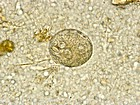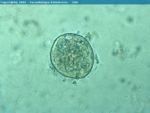Balantidium
| This article has been peer reviewed but is awaiting expert review. If you would like to help with this, please see more information about expert reviewing. |
| Balantidium | |
|---|---|
| Phylum | Ciliophora |
| Class | Litostomatea |
| Order | Vestibuliferida |
| Family | Balantiididae |
| Genus | Balantidium |
Balantidium is a ciliate protozoan found as a commensal in the lumen of the large intestine. It infects pigs and other animals, including humans. It is the only ciliate known to be pathogenic.
Identification
Balantidium can be identified by their ciliary organelles on their surface membrances. They are 80μm long and have funnel-shaped depressions leading to the cytostome (mouth). Balantidium has two nuclei, one kidney shaped macronucleus and one small micronucleus. Balantidium also has contractile and food vacuoles, which is rare in parasitic protozoa.
Life Cycle
The host ingests a cyst which passes to the small intestine and undergoes encystation to produces trophozoites. The trophozoites remain in the intestinal lumen and reproduce by binary fission. They are then released with the faeces and encyst to form new cysts. The cysts are thick-walled, ensuring infection of a new host.
Pathogenesis
Pigs are common resevoirs of Balantidium coli. It is usually found as a commensal, but may cause ulceration and dysentery if the intestinal mucosa is damaged already as the parasite will become invasive. Infected pigs shed vast numbers of cysts in their faeces. Human infection can occur via consuming contaminated foodstuffs and contact with infected pig faeces. It causes ulceration and dysentery.
Important Species
- B.coli
- This species is the cause of Balantidiasis, which is pathogenic in humans.
Test yourself with the Protozoa Flashcards
Literature Search
Use these links to find recent scientific publications via CAB Abstracts (log in required unless accessing from a subscribing organisation).
Balantidium publications
References
Melhorn, H. Encyclopedia Reference of Parasitology. Second Edition. Spring, 2001. Volume I


